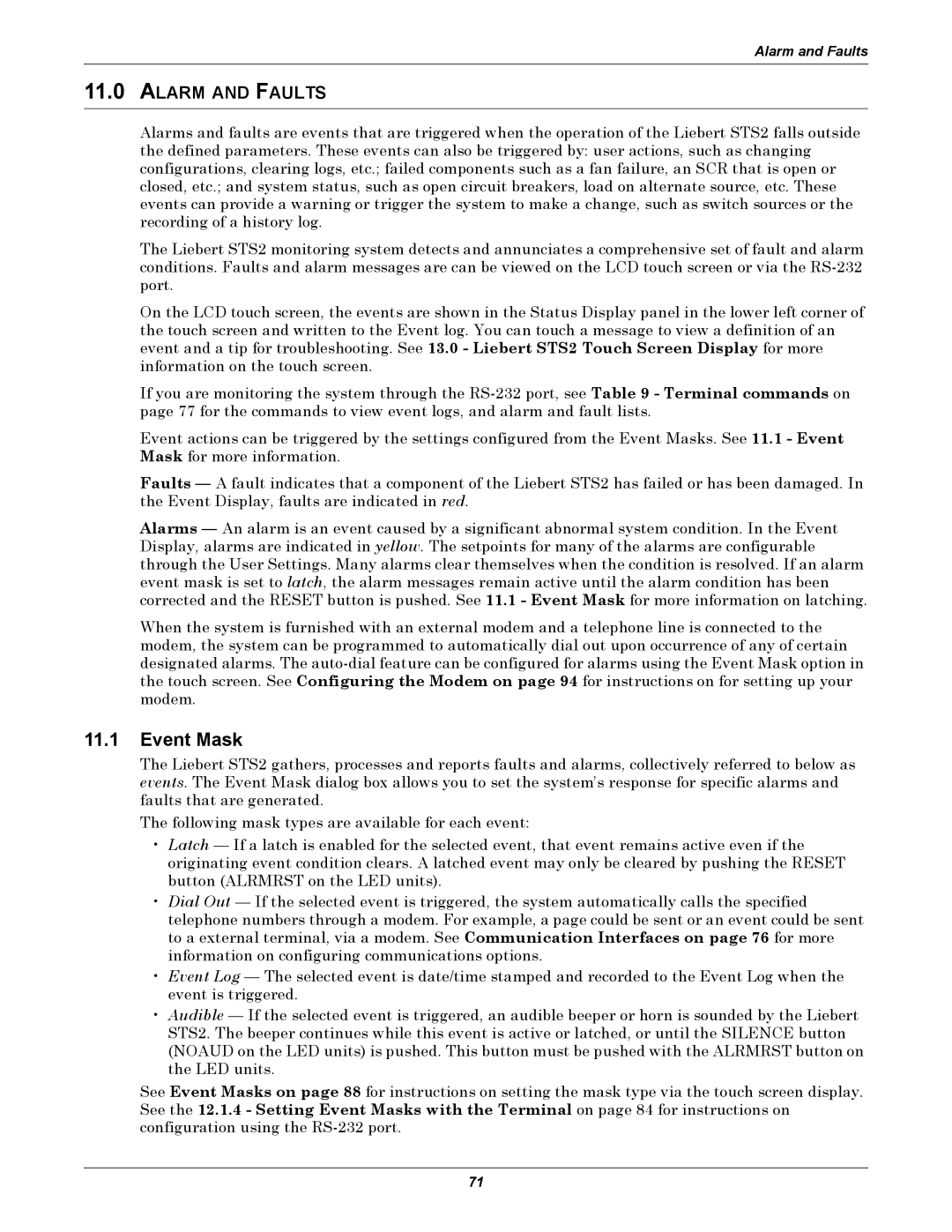
Alarm and Faults
11.0ALARM AND FAULTS
Alarms and faults are events that are triggered when the operation of the Liebert STS2 falls outside the defined parameters. These events can also be triggered by: user actions, such as changing configurations, clearing logs, etc.; failed components such as a fan failure, an SCR that is open or closed, etc.; and system status, such as open circuit breakers, load on alternate source, etc. These events can provide a warning or trigger the system to make a change, such as switch sources or the recording of a history log.
The Liebert STS2 monitoring system detects and annunciates a comprehensive set of fault and alarm conditions. Faults and alarm messages are can be viewed on the LCD touch screen or via the
On the LCD touch screen, the events are shown in the Status Display panel in the lower left corner of the touch screen and written to the Event log. You can touch a message to view a definition of an event and a tip for troubleshooting. See 13.0 - Liebert STS2 Touch Screen Display for more information on the touch screen.
If you are monitoring the system through the
Event actions can be triggered by the settings configured from the Event Masks. See 11.1 - Event Mask for more information.
Faults — A fault indicates that a component of the Liebert STS2 has failed or has been damaged. In the Event Display, faults are indicated in red.
Alarms — An alarm is an event caused by a significant abnormal system condition. In the Event Display, alarms are indicated in yellow. The setpoints for many of the alarms are configurable through the User Settings. Many alarms clear themselves when the condition is resolved. If an alarm event mask is set to latch, the alarm messages remain active until the alarm condition has been corrected and the RESET button is pushed. See 11.1 - Event Mask for more information on latching.
When the system is furnished with an external modem and a telephone line is connected to the modem, the system can be programmed to automatically dial out upon occurrence of any of certain designated alarms. The
11.1Event Mask
The Liebert STS2 gathers, processes and reports faults and alarms, collectively referred to below as events. The Event Mask dialog box allows you to set the system’s response for specific alarms and faults that are generated.
The following mask types are available for each event:
•Latch — If a latch is enabled for the selected event, that event remains active even if the originating event condition clears. A latched event may only be cleared by pushing the RESET button (ALRMRST on the LED units).
•Dial Out — If the selected event is triggered, the system automatically calls the specified telephone numbers through a modem. For example, a page could be sent or an event could be sent to a external terminal, via a modem. See Communication Interfaces on page 76 for more information on configuring communications options.
•Event Log — The selected event is date/time stamped and recorded to the Event Log when the event is triggered.
•Audible — If the selected event is triggered, an audible beeper or horn is sounded by the Liebert STS2. The beeper continues while this event is active or latched, or until the SILENCE button (NOAUD on the LED units) is pushed. This button must be pushed with the ALRMRST button on the LED units.
See Event Masks on page 88 for instructions on setting the mask type via the touch screen display. See the 12.1.4 - Setting Event Masks with the Terminal on page 84 for instructions on configuration using the
71
